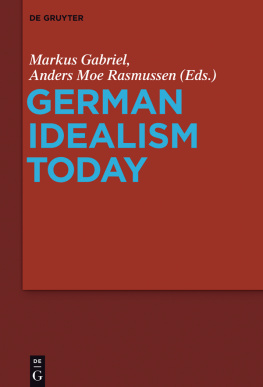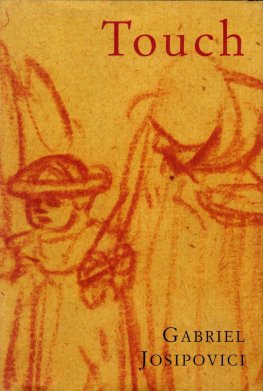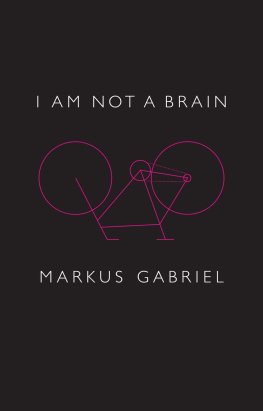Contents
Guide
Pages

Why the World Does Not Exist
Markus Gabriel
Translated by Gregory S. Moss
polity
First published in German as Warum es die Welt nicht gibt Ullstein
Buchverlage GmbH, Berlin, 2013
This edition Polity Press, 2015
Polity Press
65 Bridge Street
Cambridge CB2 1UR, UK
Polity Press
350 Main Street
Malden, MA 02148, USA
All rights reserved. Except for the quotation of short passages for the purpose of criticism and review, no part of this publication may be reproduced, stored in a retrieval system, or transmitted, in any form or by any means, electronic, mechanical, photocopying, recording or otherwise, without the prior permission of the publisher.
ISBN-13: 978-0-7456-8760-5
A catalogue record for this book is available from the British Library.
Library of Congress Cataloging-in-Publication Data
Gabriel, Markus, 1980
[Warum es die welt nicht gibt. English]
Why the world does not exist / Markus Gabriel. -- English edition.
pages cm
Translation of: Warum es die welt nicht gibt.
Includes bibliographical references and index.
ISBN 978-0-7456-8756-8 (hardback : alk. paper) 1. Ontology. 2. Postmodernism. 3. Philosophy, Modern--21st century. I. Title.
BD311.G3313 2015
111--dc23
The publisher has used its best endeavours to ensure that the URLs for external websites referred to in this book are correct and active at the time of going to press. However, the publisher has no responsibility for the websites and can make no guarantee that a site will remain live or that the content is or will remain appropriate.
Every effort has been made to trace all copyright holders, but if any have been inadvertently overlooked the publisher will be pleased to include any necessary credits in any subsequent reprint or edition.
For further information on Polity, visit our website: politybooks.com
Thinking Philosophy Anew
Life, the universe, and everything else presumably everyone has asked themselves what it all means. Where do we find ourselves? Are we only an aggregation of elementary particles in a gigantic world receptacle? Or do our thoughts, wishes, and hopes have a distinct reality and, if so, what? How can we understand our existence or even existence in general? And how far does our knowledge extend?
In this book I will develop the outlines of a new philosophy, which follows from a simple, basic thought, namely the idea that the world does not exist. As you will see, this does not mean that nothing exists at all. There are planets, my dreams, evolution, the toilet flush, hair loss, hopes, elementary particles, and even unicorns on the far side of the moon, to mention only a few examples. The principle that the world does not exist entails that everything else exists. For this reason, I can already announce that I will claim, as my first principle, that everything exists except one thing: the world.
The second principle of this book is NEW REALISM. New realism describes a philosophical stance that designates the era after so-called postmodernity (which I heralded in the summer of 2011 strictly speaking, on 23 June 2011 around 1:30 p.m. during a lunch in Naples with the Italian philosopher Maurizio Ferraris).In the first instance, then, new realism is nothing more than the name for the age after postmodernity.
Postmodernity was the radical attempt to start afresh after all of humanitys great promises had failed: from religion to modern science and all the way to the excessively radical ideas of left- and right-wing totalitarianism. Postmodernity wanted to consummate the break with tradition altogether and free us from the illusion that life has a specific meaning after which we should all strive. In order to free us from this illusion, however, it merely fabricated new illusions in particular the illusion that we are to a certain extent transfixed by our illusions. Postmodernity wanted to make us believe that, since prehistory, humanity has suffered from a gigantic collective hallucination metaphysics.
Appearance and Being
One can define METAPHYSICS as the attempt to develop a theory of the world as such. Its aim is to describe how the world really is, not how the world seems to be or how it appears to us. In this way, metaphysics, to a certain extent, invented the world in the first place. When we speak about the world, we mean everything that actually is the case, or, put differently: actuality. At this point, it is tempting to eliminate human beings from the equation the world = everything that is actually the case. For one assumes that there is a difference between things as they appear to us and how they actually are. Thus, in order to find out how they really are, one must, so to speak, remove everything that is added by man in the process of knowing.
Metaphysics has been criticized and rejected by many thinkers over the last centuries. The most recent and radical attempt to get rid of it in one stroke was postmodernism that is, essentially, the idea that we live in an entirely post-metaphysical age, an age defined by the alleged fact that we have given up believing in the idea of a reality hidden behind the appearances. One could say that postmodernisms objection against metaphysics was that things exist only insofar as they appear to us. Accordingly, there is absolutely nothing further behind the appearances, no world or actuality in itself. Some less radical postmodernists, such as the American philosopher Richard Rorty, thought that there might in fact still be something behind the world as it appears to us. However, he thought that this could play no role for us as human beings, so he instead suggested that we increase solidarity among human beings rather than look for ultimate Truth (with a capital T) or ultimate Reality (with a capital R).
However, postmodernism, arguably, was only yet another variation on the basic themes of metaphysics in particular, because postmodernism was based on a very general form of constructivism. CONSTRUCTIVISM assumes that there are absolutely no facts in themselves and that we construct all facts through our multifaceted forms of discourse and scientific methods. There is no reality beyond our language games or discourses; they somehow do not really talk about anything, but only about themselves. The most important source and forefather of this tradition is Immanuel Kant. Kant indeed claimed that we could not know the world as it is in itself. No matter what we know, he thought that it would always in some respect have been made by human beings.
Let us take an example that is often used in this context, namely colors. Ever since Galileo Galilei and Isaac Newton, it has been suspected that colors do not actually exist. This assumption so exasperated colorful characters such as Goethe that he composed his own Doctrine of Colors. One might think that colors are only waves of a determinate length that strike our sensory receptors. The world in itself is actually completely without color, and it consists only of elementary particles which appear to us on a medium-sized scale where they somehow mutually stabilize one another into structures we perceive as bodies extended in space and time. It is exactly this thesis that is a widespread form of metaphysics in our time. It claims that, in itself, the world is completely different than it appears to us. Now Kant was still much more radical. He claimed that even this assumption (or perhaps supposition?) about particles in space-time is only a way in which the world, as it is in itself, appears to us. How it actually is, that is something we could absolutely never discover. Everything that we know is made by us, and just because of this we are also able to know it. In a famous letter to his fiance, Wilhelmine von Zenge, Heinrich von Kleist illustrates Kantian Constructivism in the following way:












